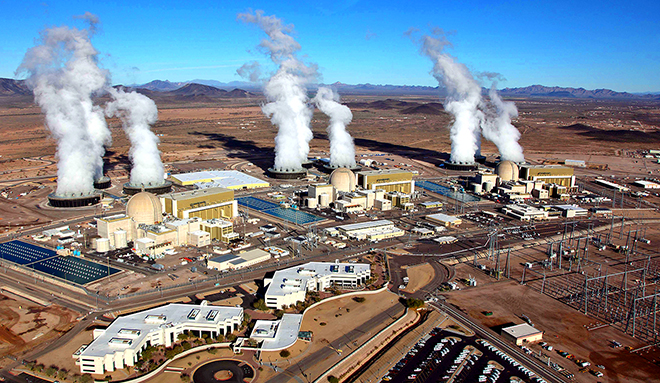S&P Global Offerings
Featured Topics
Featured Products
Events
S&P Global Offerings
Featured Topics
Featured Products
Events
S&P Global Offerings
Featured Topics
Featured Products
Events
Banking & Capital Markets
Economy & Finance
Energy Transition & Sustainability
Technology & Innovation
Podcasts & Newsletters
Banking & Capital Markets
Economy & Finance
Energy Transition & Sustainability
Technology & Innovation
Podcasts & Newsletters
S&P Global Offerings
Featured Topics
Featured Products
Events
6 Apr, 2021
By Ellie Potter

|
The Palo Verde power plant in Arizona is the largest nuclear facility in the U.S. Arizona Public Service, which partially owns the facility, is working with the U.S. Department of Energy to produce hydrogen from the plant. |
Commercial-scale hydrogen production from nuclear reactors is on the horizon, but its potential deployment will ultimately hinge on federal policies to drive market demand, private sector investment, and infrastructure build-out, experts said.
"We're going to see new technologies ready for the market this decade," said John Kotek, vice president of policy development and public affairs at the Nuclear Energy Institute. "The question is going to be: do the policy frameworks and other incentive systems line up to create the demand-pull to really accelerate the deployment of those new technologies?"
Experts have said that nuclear-produced hydrogen could be commercially viable in the next 10 years and perhaps even by the mid-2020s if several demonstration projects prove successful. But the federal government has a role to play in driving down the technologies' cost and streamlining regulatory processes to hasten its build-out, observers said. Doing so could help the nation, the energy industry, and the transportation and industrial sectors decarbonize.
The U.S. produces about 10 million tonnes of hydrogen annually, largely for the refining and chemical industries along the Gulf of Mexico. But if nuclear power is to play a role in producing the fuel, new infrastructure would need to be built to carry the clean gas from where many nuclear plants are located, in the East and Midwest, to where it will be used, observers said. Eventually, new nuclear reactors could be built near hydrogen demand sites as well.
"The potential for scaling up hydrogen production is there. A lot of it will depend on the federal government support for it," said Patrick Burke, Xcel Energy Inc.'s vice president of nuclear strategy and innovation. "It's an early technology, and we would anticipate the price to come down as we scale the technology up. So, if they can incentivize the development of that technology, that would be helpful."
Industry observers and representatives specifically called for federal tax credits to help deploy green hydrogen technologies, including those involving nuclear generation, spurring private investment in the sector. Applying market-based tools, such as a clean energy standard, that value all zero-carbon generators, including nuclear reactors, could also help, they said.
"We would like to see a more technology-neutral federal policy," said Michael Green, Arizona Public Service Co.'s general manager for nuclear policy. "Most investors are looking for significant federal policy movements before they get behind a technology. We think that the direction of the current Congress is very favorable for all carbon-free technology, and it ought to be all-inclusive."
Lawmakers have introduced several bills that could support green hydrogen development, including its production using nuclear energy. President Joe Biden in recent months has also signaled his support for hydrogen and nuclear energy.
Jeremy Harrell, managing director of policy at ClearPath, a nonprofit focused on advancing conservative climate and energy solutions, said he expects to see more bills introduced in the next month or two that aim to incentivize investments in the space. The impending infrastructure package could also offer an opportunity for the green hydrogen sector, especially since hydrogen was not as prominent in the energy bill Congress passed in late 2020, Harrell said.
"I think it's absolutely an opportunity to help drive demand, generate some revenue for some of these clean energy engines, like our existing nuclear facilities," Harrell said. "The administration is saying, 'Build back better.' We need to build cleaner faster."
The U.S. is trailing other nations in green hydrogen production and needs to proactively develop a domestic manufacturing base and markets to compete, asserted Julio Friedmann, senior research scholar with the Columbia University Center on Global Energy Policy. But Friedmann said existing regulatory frameworks, proposed policies and demonstration projects can also "make a case for investment and project development."
"These are not engineering decisions," Friedmann said. "These are policy decisions. We will choose whether or not we do this. ... What I'm optimistic about is that the policy framework for low-carbon hydrogen in general, for green hydrogen from nuclear in particular, means that there will be successes soon and that we can build on those successes soon."
The push toward a net-zero carbon emissions world makes hydrogen produced from nuclear energy all the more appealing, the scholar said.
"It looks interesting as a way to get experience and scale up zero-carbon hydrogen production," Friedmann said. "It looks like a way to make money. It looks like a way to develop standards and grow markets. That's exciting. Whether we'll do it in the next five or 10 years remains to be seen."
